Many folks are considering M.Zuiko 150-600 vs. 100-400 comparison information to help determine if the new lens is suitable for their needs. This posting should not be considered as a technical comparison. It is intended to be a practical hands-on comparison based on a reasonable amount of field work done with these lenses.
We’ll be touching on a number of topical areas which include: cost, size and weight, build quality, image quality, image stabilization, field flexibility, and overall handling. It is important to keep in mind that these are my subjective assessments as a photographer who hates to use tripods.
NOTE: Click on images to enlarge.

Cost: Advantage M.Zuiko 100-400
An important consideration for most photographers is the cost of new photographic gear. Without question the M.Zuiko 150-600 mm f/5-6.3 IS requires a more significant investment than the M.Zuiko 100-400. At $3,600 CDN compared to $2,200 CDN, the M.Zuiko 150-600 represents a cost difference of $1,400 CDN plus tax. This is not an inconsequential amount of money for most people and represents an increase of about 64% over the M.Zuiko 100-400.

The question that begs to be answered for many people is whether they can justify making this level of investment in a new, longer telephoto zoom lens. Especially if they already own the M.Zuiko 100-400 mm f/5-6.3 IS zoom. As regular readers know, I’ve been shooting extensively with the M.Zuiko 100-400 for the past number of years, and have very much enjoyed using this lens.

The M.Zuiko 100-400 is certainly a capable lens that would meet the needs of many photographers. From a pure cost perspective the M.Zuiko 100-400 has a clear advantage.

Size and Weight: Advantage M.Zuiko 100-400
Another obvious advantage for the M.Zuiko 100-400 is its comparatively smaller size and weight. With tripod collar and hood the M.Zuiko 100-400 weighs about 1.4 Kg (~3.1 lbs.). This compares to the M.Zuiko 150-600 coming in at 2.243 Kg (~4.9 lbs.) as noted in an article by Petr Bambousek.

Depending on an individual photographer’s shooting style and handholding technique this difference of 0.843 Kg (~1.8 lbs,) could be a deal breaker for some folks. If they regularly use a tripod or monopod then the weight differential may not be an issue.

On a personal basis I’ve been pleasantly surprised with how the weight of the M.Zuiko 150-600 mm f/5-6.3 IS actually feels when using it handheld in the field. Yes… I can feel a difference, but it is well within my personal handheld limits. I’ve shot with the M.Zuiko 150-600 for 5-6 hours per day on successive days and have not experienced any arm, neck or back pain/fatigue.

To be fair I should mention that I shoot with an E-M1X which is an exceptionally comfortable camera body to use. I also periodically clip the M.Zuiko 150-600 onto my Cotton Carrier G3 Harness when there are lulls in the photographic action. I also have done this when using the M.Zuiko 100-400 since acquiring my G3 Harness.

Sometimes it is hard to visualize how two lenses compare in terms of sizing, so I took a short series of comparison photographs. The image above shows the fully retracted lengths of both lenses when each is mounted on an E-M1X body. The tape measure provides a rough approximation for the difference in length.

As you can see in the image above, once both lenses are fully extended the length differential between the two lenses is more pronounced.
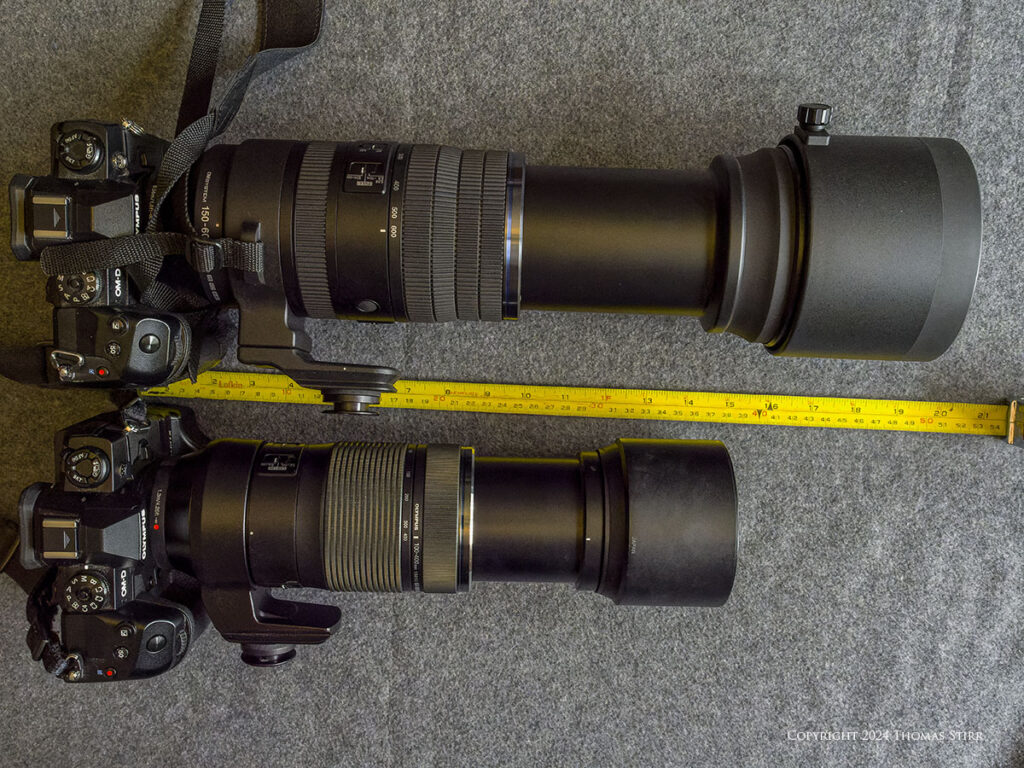
Once the lens hoods for each lens are attached, the overall difference in length becomes even greater. Some photographers may find that they want/need to use a tripod or monopod to be able to handle a lens that is about 43 cm (~16.9 inches) long when fully extended with lens hood. If you already own an M.Zuiko 100-400, or are trying to decide between these two lenses… hopefully these last three images will be helpful for you.

On a personal basis I haven’t found the weight, size and length of the M.Zuiko 150-600 to be any kind of a problem for me when shooting handheld. I have no plans whatsoever to use a tripod or monopod with this lens. But… that’s based my experience with these two lenses and other equipment I’ve used previously.
I have owned full frame gear in the past… and shot with a Nikon D800/Tamron 150-600 combination back a number of years ago. So, I’m not unaccustomed to shooting with heavier camera gear.

My E-M1X/M.Zuiko 150-600 combination feels more balanced in hand, and is far less tiring for me to use than was my full frame gear. I think the key difference is the comfort of the E-M1X’s grip.

Build Quality: Advantage M.Zuiko 150-600
The difference in build quality is immediately noticeable when holding and using these two lenses. The zoom action is smoother on the M.Zuiko 150-600, especially when using the standard “S” setting.

Like many other people, I found the lens mount on my M.Zuiko 100-400 to be a bit sloppy. This concerned me at first… but it didn’t take long before I just ignored that issue and never gave it another thought. The lens mount is tighter on the M.Zuiko 150-600, although not quite as tight as it is with a lens like the M.Zuiko PRO 40-150 mm f/2.8.

The controls on the lens barrel of the M.Zuiko 100-400 are much stiffer and harder to operate than those on the M.Zuiko 150-600. The overall fit and finish with the 150-600 feels and looks better. Although not a PRO lens, the 150-600 does feel like it is a definite step above the 100-400.

Image Quality: Advantage M.Zuiko 150-600
The M.Zuiko 150-600 mm f/5-6.3 is sharper than the 100-400, and is capable of producing some terrific images. Obviously some work can be done in post to help mitigate lens softness regardless of the camera gear that is being used. Having said that, there still is a difference between the two lenses.

Some readers have mentioned to me that one or two ‘reviewers’ claim that the M.Zuiko 150-600 is disappointing in terms of its sharpness. All I can say in response is that specific lenses may challenge us more than others. There may be occasions when we may not have the requisite skills to use the gear properly and effectively.

Another difference with the 100-400 is that the colour rendition is richer and has some additional punch with the M.Zuiko 150-600. I find that I spend very little time working with my 150-600 RAW files in post.

Let’s have a look at two handheld images captured under poor light from the same approximate distance, using the same camera at approximately the same settings.
The image above was captured using the M.Zuiko 100-400 mm f/5-6.3 IS. Note the brownish cast with the Multi-Purpose Oil can image. The photo lacks some ‘pop’.
Now let’s look at the same subject, photographed from the same chair in my office, at roughly the same camera settings, under the same lighting. These two sample images were processed in exactly the same way in post.
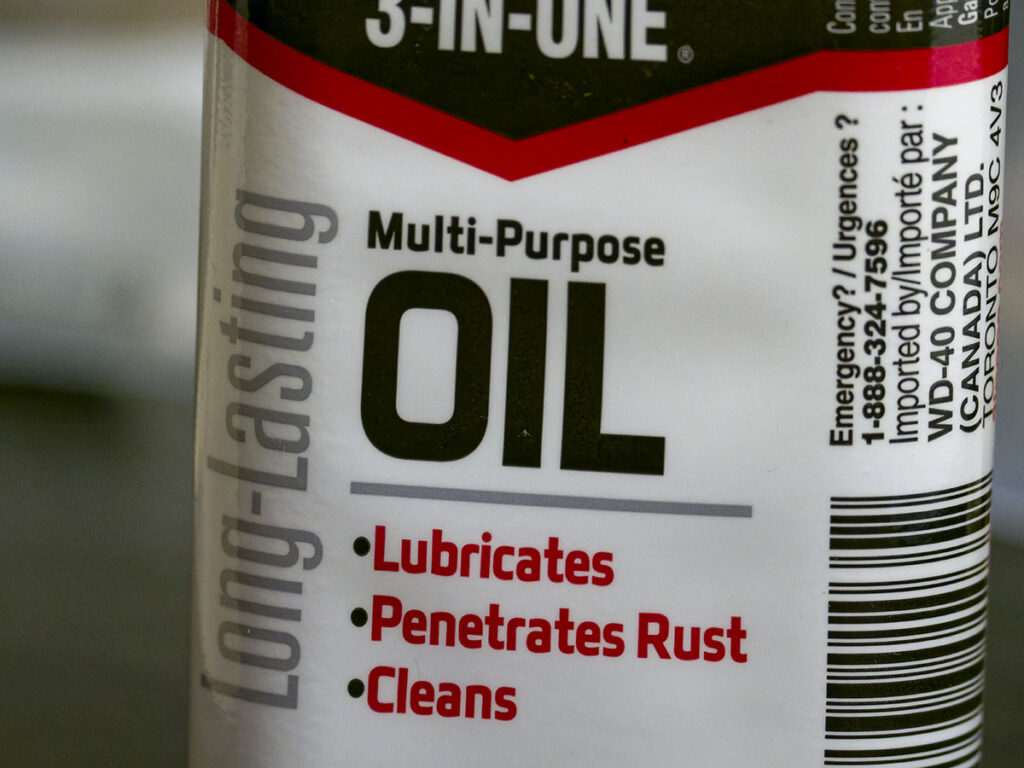
We can see that the image captured with the M.Zuiko 150-600 mm f/5-6.3 IS has much cleaner white areas. The photograph has better overall contrast and more snap to the red. The M.Zuiko 150-600 does a significantly better job capturing the actual colours of this oil can under low light conditions.
The optical formulation of a lens does make a difference. The M.Zuiko 100-400 has eight special lens elements consisting of 4 ED, 2 HR and 2 Super HR. In comparison, the M.Zuiko 150-600 has thirteen special lens elements consisting of 2 ED, 4 Super ED, 6 HR and 1 HD.
If you look at the EXIF data in the two images you’ll also see that I used the M.Zuiko 150-600 from a distance of 1.4 metres. Some folks are under a misconception that the minimum focusing distances of this lens are 0.56 metres on the wide end, and 2.8 metres on the telephoto end, with nothing in between.
The reality is that if you are inside the 2.8 metre minimum focusing distance on the telephoto end you can simply shorten your focal length until the 150-600 can grab focus. In this case I used a focal length of 328 mm with the 150-600 and 400 mm with the 100-400.
As you can see, the word ‘OIL’ is pretty close in size between the two images. With the 150-600 I could have moved in much closer to the subject physically.
At a 150 mm focal length from the minimum focusing distance of 0.56 metres the word ‘OIL’ would have been larger in my composition than the one captured with the 100-400 at 1.3 metres away using a focal length of 400 mm.
In short, the 2.8 metre minimum focusing distance on the telephoto end of the 150-600 is nothing that should be of concern.

Image Stabilization: Advantage M.Zuiko 150-600
The M.Zuiko 150-600 mm f/5-6.3 IS provides Sync-IS with compatible OM /Olympus bodies. This makes a significant difference when shooting at slower shutter speeds. The image above was captured handheld at 1/13 of a second with the M.Zuiko 150-600 fully extended to 600 mm (efov 1200 mm).

The Sync-IS on the M.Zuiko 150-600 mm f/5-6.3 provides 7 EV stops on the 150 mm wide end, and 6 EV stops on the 600 mm telephoto end.

By comparison the image stabilization on the M.Zuiko 100-400 is limited to 3 EV stops and does not sync with an OM/Olympus body. I’ve had the image stabilization on my 100-400 turned off for the past number of years, and have been relying on the IBIS in my E-M1X.

Can 7 EV stops of Sync-IS on the 150 mm end, and 6 EV stops on the telephoto end actually be achieved handheld? That would mean being able to shoot handheld at 600 mm (efov 1200) using a shutter speed of 1/20. At a focal length of 150 mm (efov 300 mm) that would mean being able to use a handheld shutter speed of 1/2 second.
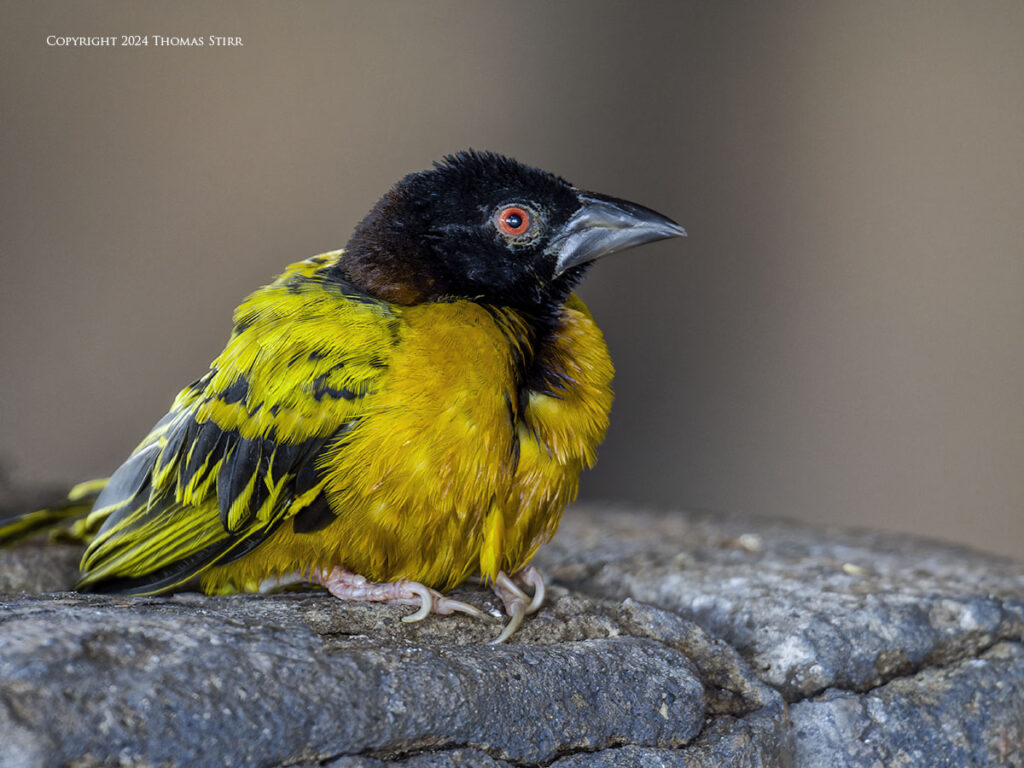
As illustrated in an earlier article, shooting handheld using a focal length of 600 mm (efov 1200 mm) and a shutter speed of 1/20 or slower is possible.

And just for the heck of it, I tried a 1/2 second handheld image of that same Multi-Purpose Oil can this evening. I was able to be successful shooting handheld at 1/2 second numerous times… so the sample image above wasn’t a “one of”.

Field Flexibility: Advantage M.Zuiko 150-600
Having 50% more reach (i.e. 400 mm vs. 600 mm) on the long end of a telephoto lens makes a huge difference when in the field. This is especially true when that additional reach does not come with any penalty in terms of loss of light.

To achieve roughly the same focal length range as the M.Zuiko 150-600 does natively at f/5 to f/6.3, I would need to use the MC-14 teleconverter with the M.Zuiko 100-400. This would give me a focal range of 140 to 560 mm, but I would lose one EV stop of light and have to shoot at f/9 when fully extended.
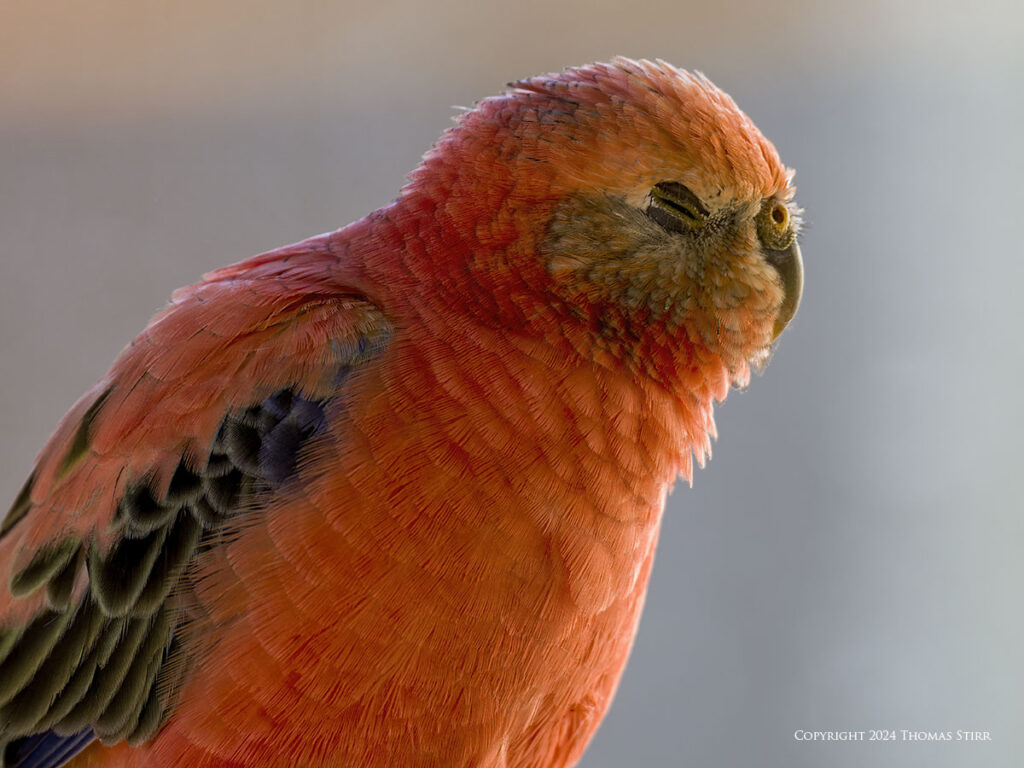
Using the MC-14 on the 150-600 fully extended at f/9 is like using the 100-400 with the MC-20 at f/13 in terms of reach. Any way you cut it, the 150-600 provides more reach than the 100-400 and saves one EV stop of light at the long end. This makes the M.Zuiko 150-600 a lot more flexible in the field.

As noted earlier the Sync-IS is superb with up to 7 EV stops on the wide end and 6 EV stops on the telephoto end. This opens up a lot more opportunities to shoot under poor light conditions with the 150-600. Having a short minimum focusing distance of 0.56 metres at 150 mm also opens up a lot more in-field photographic potential.

Overall Handling: Advantage M.Zuiko 150-600
This may surprise some people, but in my view the handling of the M.Zuiko 150-600 easily outpaces the M.Zuiko 100-400. I absolutely love the standard “S” setting and using the push/pull action to adjust focal length. This is far more intuitive to use that having to turn a focal length ring on a lens like the 100-400. I find it much easier to adjust focal length while panning with a bird-in-flight when using the M.Zuiko 150-600.

The M.Zuiko 150-600 also has the added advantage of being able to focus with a minimum focusing distance of 0.56 metres rather than 1.4 metres with the 100-400. Add Sync-IS to the mix and the handling of the 150-600 is an absolute joy.

Internet Inaccuracies
Unfortunately the internet has its fair share of trolls that spread rumours and inaccuracies. Such is the case with both the M.Zuiko 150-600 mm f/5-6.3 IS and the M.Zuiko 100-400 mm f/5-6.3 IS.
Some rather uninformed trolls claim that the M.Zuiko lenses are nothing more than a rebranded Sigma lens. It would appear that these folks are too lazy to even visit these two manufacturers’ websites and check the published information.
It certainly is plausible, or likely, that the M.Zuiko 150-600 mm f/5-6.3 IS may be manufactured by Sigma under some kind of contract manufacturing arrangement. As discussed in a previous article, these types of business relationships have been a part of the photographic market for many years.
Where a specific lens is manufactured does not automatically mean that it is a copycat lens with a different brand name slapped on it. There are important differences between the M.Zuiko 150-600 mm f/5-6.3 IS and the Sigma Sport 150-600 mm for Sony as noted on the manufacturer’s websites.

As we can see from a graphic published on the OM Digital Solutions website, the M.Zuiko 150-600 mm f/5-6.3 IS has 13 special elements including 2 ED, 4 Super ED, 6 HR, and 1 HD.
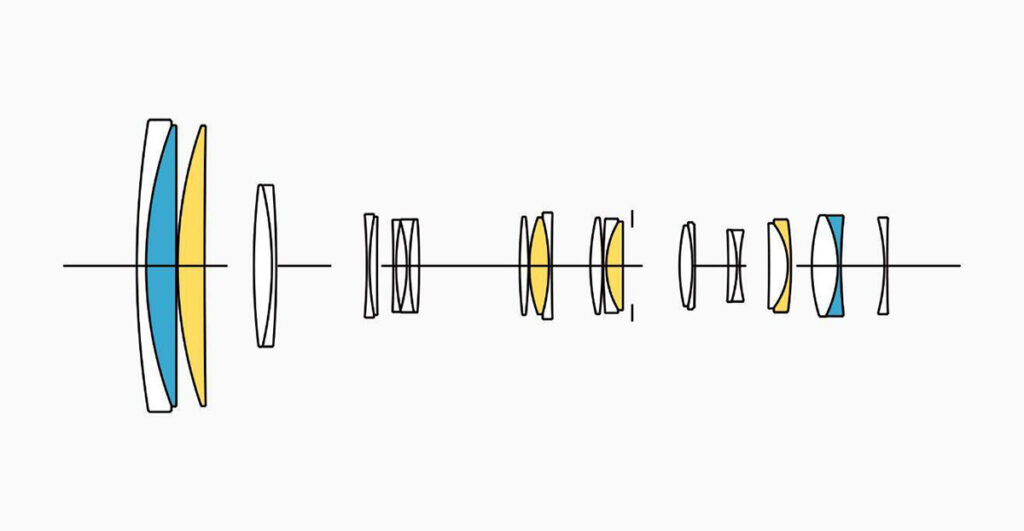
The Sigma website for the Sport 150-600 mm for Sony shows the graphic above with 6 special elements which include 2 SLD glass and 4 FLD glass.
There is no reference at all to the other 7 special elements found in the M.Zuiko 150-600 mm f/5-6.3 IS when it comes to the Sigma branded product.
As noted earlier the M.Zuiko 100-400 has 8 special elements including 4 ED, 2 HR and 2 Super HR. The Sigma 100-400 is showing 5 special elements including 4 SLD glass and 1 FLD glass.
The M.Zuiko 150-600 mm f/5-6.3 IS is IPX1 rated. To learn more about how Olympus engineered its weather proofing this link may be of interest. My assumption is that OMDS is continuing with the weather sealing approach pioneered by Olympus as the OM1 Mark II is IP53 rated.
By comparison the Sigma 150-600 Sport for Sony does not have an IPX1 rating. Information on the website states that there is “special sealing at the mount connection, manual focus ring, zoom ring and cover connection.” This statement implies that there is no special weather sealing around the switches on the barrel or on the custom function buttons. Compare this with the IPX1 approach taken by Olympus/OMDS.
Similarly the M.Zuiko 100-400 mm f/5-6.3 IS is IPX1 rated. The Sigma 100-400 is not, and only claims to have a “mount with dust and splash resistant structure. The lens mount incorporates rubber sealing to protect the mount from dust and water drops.”
As noted earlier, the M.Zuiko 150-600 provides 7 EV stops of Sync-IS at the 150 mm focal length and 6 EV stops of Sync-IS on the 600 mm focal length. The Sigma 150-600 Sport for Sony is showing 4 EV stops of image stabilization. Specifications are subject to change of course. If the image stabilization of the Sigma 150-600 Sport for Sony does improve in the future, it might be because Sigma has licensed the use of OMDS image stabilization technology.
So, the bottom line is not to believe the drivel posted by uninformed trolls. There are significant differences between M.Zuiko 150-600 and 100-400 lenses and similar focal range Sigma lenses.
So, while the M.Zuiko 150-600 mm f/5-6.3 IS may be made by Sigma under a contract manufacturing agreement… but that doesn’t mean that they are copycat lenses. Check out the information on these lenses on the respective manufacturer websites so you can educate yourself on the differences.

Summary
The M.Zuiko 100-400 mm f/5-6.3 IS and its larger brother the M.Zuiko 150-600 mm f/5-6.3 IS, both have a place in today’s photographic market. If good reach, cost, size and weight are a photographer’s primary concerns, the M.Zuiko 100-400 may be an ideal solution.
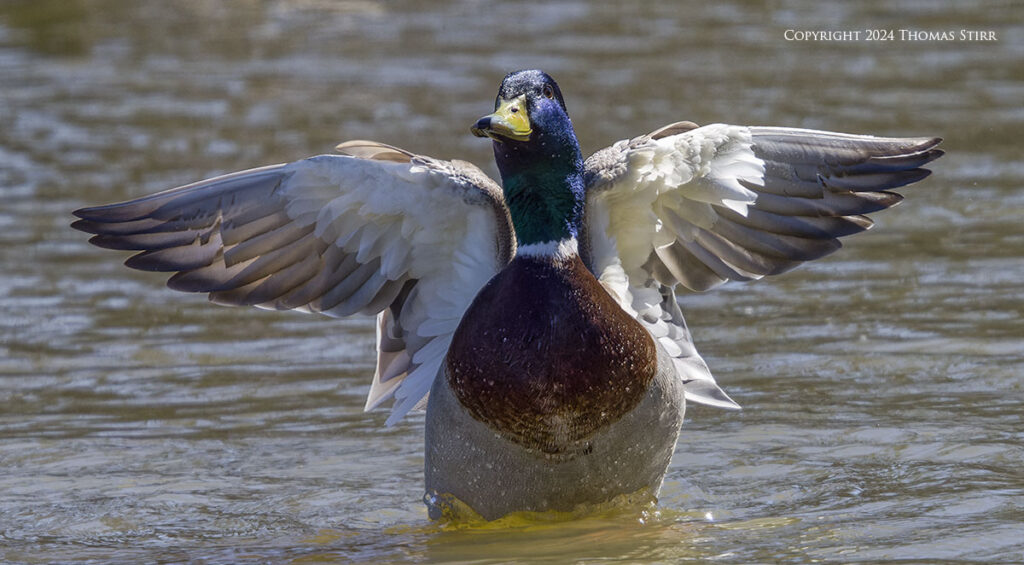
Others photographers who are looking to expand their image making potential with more reach, better quality images, and improved slow shutter speed shooting with Sync-IS… may find that the M.Zuiko 150-600 is a more attractive option.
This will depend on their ability to handle the size and weight of the M.Zuiko 150-600, and if they are prepared to make a more sizeable investment in that lens.

From my perspective I’ve been extremely pleased with the quality, handling and overall performance of my M.Zuiko 150-600 mm f/5-6.,3 IS zoom. This lens has quickly become my ‘go to’ birding and nature lens. I will be keeping my M.Zuiko 100-400 but primarily as a travel companion lens for my M.Zuiko PRO 12-100 mm f/4 IS.
Once a photographer uses the M.Zuiko 150-600 it can be very difficult to go back to the M.Zuiko 100-400. The M.Zuiko 150-600 performs at a higher level optically, handles much better… and is a lot more fun to use.
Technical Note
Photographs were captured handheld with the camera equipment noted in the EXIF data. All images were created from RAW files using my standard process. This is the 1,371 article published on this website since its original inception in 2015.

How you can help keep this site advertising free
My intent is to keep this photography blog advertising free. If you enjoyed this article and/or my website and would like to support my work, you can purchase an eBook, or make a donation through PayPal. Both are most appreciated.
Sometimes all we need as photographers is a bit of inspiration. We hope you can find some of that inside Finding Visual Expression II.
Finding Visual Expression II is available for download for an investment of $11.99 CDN. The best viewing experience of this eBook will be at 100% using Adobe Acrobat Reader.
You may be interested in all of the 30 concepts covered in both of these related eBooks. If so, you may want to also consider Finding Visual Expression.
Finding Visual Expression is available for download for an investment of $11.99 Cdn. The best viewing experience of this eBook will be at 100% using Adobe Acrobat Reader.
Our other eBooks include Images of Ireland, New Zealand Tip-to-Tip, Nikon 1: The Little Camera That Could, Desert & Mountain Memories, Images of Greece, Nova Scotia Photography Tour, and a business leadership parable… Balancing Eggs.
If you click on the Donate button below you will find that there are three donation options: $7.50, $10.00 and $20.00. All are in Canadian funds. Plus, you can choose a different amount if you want. You can also increase your donation amount to help offset our costs associated with accepting your donation through PayPal. An ongoing, monthly contribution to support our work can also be done through the PayPal Donate button below.
You can make your donation through your PayPal account, or by using a number of credit card options.
Word of mouth is the best form of endorsement. If you like our website please let your friends and associates know about our work. Linking to this site or to specific articles is allowed with proper acknowledgement. Reproducing articles, or any of the images contained in them, on another website or in any social media posting is a Copyright infringement.
Article is Copyright 2024 Thomas Stirr. Images are Copyright 2022-2024 Thomas Stirr. All rights reserved. No use, duplication or adaptation of any kind is allowed without written consent. If you see this article reproduced anywhere else it is an unauthorized and illegal use. Posting comments on offending websites and calling out individuals who steal intellectual property is always appreciated!

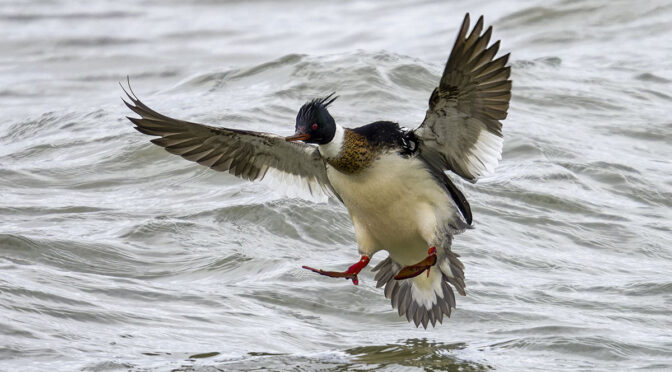


Hello Thomas;
just a small nit to pick. You said that the push-pull action of the 150-600 was better for you than turning the zoom ring on the 100-400. My 100-400 can be push-pulled by grabbing the very front of the lens. I’ll agree that is better ergonomics – I use 100 to find the bird and a quick push extends it to 400 for the photo.
Hi Charles,
I agree that a push-pull action can physically be done with the M.Zuiko 100-400. The stiffness of that action with the 100-400 is nowhere close to how smooth and effortless as it is with the M.Zuiko 150-600. The 100-400 is considerably stiffer to operate with a push/pull motion. To me, it really is night and day. Of course I can only comment based on my copies of those lenses.
Whether a push/pull action should be used with a specific zoom lens is another question. I do not recall that a push-pull action is recommended/suggested in the user manual of the M.Zuiko 100-400, as it is with the M.Zuiko 150-600.
I could not find a verifiable online reference, but there is information stating that damage can be caused when using a push/pull action with lenses that are not designed for this type of use. “Push/pull mechanisms rely on specific internal structures and gearing. Applying force where it’s not intended can strain or break these parts, leading to the lens becoming unusable.”
Tom
Hi Thomas,
It would be lovely if you can compare 150-600mm with 100-400mm IS II version.
Cheers,
Worapoj
Hi Worapoj,
I don’t have any access to a review sample of the M.Zuiko 100-400 f/5-6.3 IS II version lens, so that is not possible for me to do.
Tom
Hi Thomas
Great insightful article as usual. I have the 100-400 and I’m always interested in what else is out there.
The difference in quality on the shots of the oil label are incredible. I’ll have to look into my copy of the 100-400 to see if its colours are different, I’ve never noticed.
Out of interest what is the lens aperture at 400mm? Also what are the values when adding a TC?
I can see sync IS being a massive advantage over the 100-400.
Thank you again for a great review and your continued posts which I always enjoy.
Kind regards
Mark
Hi Mark,
I’m glad you are enjoying the articles 🙂
At 400 mm with the M.Zuiko 150-600 mm f/5-6.3 IS wide open the aperture is f/6.1. By 475 mm or so you’d be at f/6.3. When using the MC-14 you’ll add 1 full stop (i.e. f/9) when the lens is fully extended. With the MC-20 you’ll be adding 2 full stops (i.e. f/13) when the lens is fully extended.
Here’s a link to an article I wrote about the Sync-IS on the M. Zuiko 150-600: https://smallsensorphotography.com/m-zuiko-150-600-sync-is
Tom
Thank you
Thank you for the article, Thomas. Very informative. I already have the 100-400 and my copy – when I do my part correctly – is extremely sharp. I actually think that the reduction in sharpness in some of my shots are related to small shifts in focus , not to problems with the glass as such. However, I do love extreme telephoto use so I’m certainly curious about the 150-600. The size doesn’t bother me , for a 1200mm fov it’s not a big lens anyway.
The two oil can shots are curious though. My first thought is that the differing lens elements have thrown out the white balance setting between the two examples. Did you play around with the 100-400 raw WB temperature to see if you can remove the colour cast and make the white actually white? I don’t see why Dx0 /4 would give such a different rendering to Dx07 but maybe it’s related to that? But I’ve no doubt that you would have already considered such things.
All the best, and I look forward to your further articles.
Hi Jason,
We seem to have a number of readers that are interesting in the 150-600. The more I use this lens the more latitude I discover.
I didn’t bother playing with the white balance at all… I just used the same approach with the images to see what would happen. From what I remember I think I used PhotoLab 7 to process all of the oil can images.
Tom
The oil can shots make very clear the potential improvement in sharpness with this lens.
I’m not an expert in lens optics, but my impression is that the lens design is very similar between the Sigma 150-600mm Sport and the OM 150-600. They both have 25 elements in 15 groups. The terminology of what makes up those elements seems to be brand-based, e.g. 4 Super ED for OM and 4 FLD for Sigma; 2 ED for OM and 2 ELD for Sigma. The sync-IS and the 4/3 sensor adaptation are the two definitive changes in my view.
But whether this is a somewhat redesigned Sigma lens or a substantially customized design doesn’t matter. The bottom line is that it provides amazing reach, great stabilization, and crisp images at a relatively affordable price (that will probably go down eventually).
Hi Stephen,
I agree with the bottom line articulated in your comment… “The bottom line is that it provides amazing reach, great stabilization, and crisp images at a relatively affordable price”.
Where our assessments vary is that I don’t see any large discounts on this lens in the future. Strategically I think the M.Zuiko 150-600 mm f/5-6.3 IS is perfectly positioned between the PRO 150-400 TC1.25 and the 100-400 mm f/5-6.3 IS and I don’t see why OMDS would feel any compulsion at all to significantly decrease the price of this lens. The PRO 150-400 f/4.5 TC-1.25 has been out for a couple of years now and I’ve never seen it discounted even by a penny. We may see the same kind of inelastic pricing with the 150-600. The more differentiated a product is… the more inelastic the price becomes.
I have no idea about the terminology of the 6 special elements you cited in the OM and Sigma products… and if these are actually identical glass elements. What we do know is that the M.Zuiko 150-600 also has 7 more special elements including 6 HR and 1 HD element.
Tom
I thought that possibly the HR & HD elements are also used in the Sigma lens, but not touted as anything special. However, I see one Sigma lens that does tout 4 HR elements, the 85mm f/1.4. So these extra elements may be unique to this lens’s OM System version.
It does seem that OM System lens sales don’t have huge markdowns, maybe a few hundred dollars at best. Possibly a used/refurbished 150-600 will be the only route to significant savings.
Hi Steve,
I would assume that if the Sigma 150-600 actually had 13 special elements, i.e. not just standard glass for the HR and HD elements, that the company would promote it as such. Otherwise they would be leaving differentiation and customer value on the table. Not detailing all special elements in a lens would be both illogical, and ridiculous from a strategic marketing perspective.
In my experience M.Zuiko lenses are outstanding in terms of quality and performance. This is especially true of the PRO lenses. I never hesitate to shoot any of my M.Zuiko lenses wide open when needed.
I think OM/Olympus don’t heavily discount their lenses simply because they don’t have to do so. OM/Olympus users recognize the quality and performance of these lenses and are willing to pay what is asked for them… or within a couple of hundred dollars of list.
Tom
Hi Thom,
Thank you for a very informative and thoughtful article. I agree that the images which you put up to illustrate the differences between the two lenses do show the 150-600mm as being sharper and having better color rendition. Are these images JPEGs, straight out of the camera? Or has a certain amount of post processing been done? It is just that I would like to know that I am comparing apples with apples. I probably sound a bit pedantic, however there is a significant difference in online opinion, as to the quality of the 150-600mm lens. I just think it would be a really useful lens where you are shooting from a vehicle or a boat, and don’t have control over the subject distance. I currently use Sony and the alternative would be the 200-600mm with some cropping or a teleconverter. Very little difference in weight, however a significant difference in dimensions and magnification.
Hi Tony,
You ask a very prudent question.
All of the images for both cameras were created from RAW files using the same approach in post processing. DxO PhotoLab 4 was used for the M.Zuiko 100-400 photographs and DxO PhotoLab 7 was used for the M.Zuiko 150-600 images. Other than that the other software programs used were the same, i.e. PhotoShop CS6, an old version of the Nik Collection, and early versions of Topaz DeNoise AI and Topaz Sharpen AI.
My basic approach in post was outlined in my reply to another comment posted on this article by Reno. I don’t spend a lot of time with my images in post with the average RAW file taking about 3 minutes or so. If it looks like I need to spend more than 5 minutes with a RAW file, I typically just move on to another photograph and accept the fact that I did not do a good job properly capturing the particular image from which I’ve moved on.
On a personal basis I don’t put any stock in the vast majority of online opinions about any product. When it comes to OM/Olympus gear I much prefer to look at the work of professional, award winning photographers like Petr Bambousek, Andy Rouse and David Tipling to name a few. Chris Eyre-Walker also creates some worthwhile assessments.
Have a look at Petr Bambousek’s M.Zuiko 150-600 first impressions article, especially his comments about the sharpness of this lens. Then have a look at Petr’s award winning work. When a pro like Petr states that the M.Zuiko 150-600 is a sharp lens, although not quite to the level of the M.Zuiko PRO 150-400, he is putting his reputation on the line. That means a lot to me.
Each of us should buy the camera gear that best suits our specific needs. For some folks that is larger format gear like medium format or full frame. For other folks like me, OM/Olympus M4/3 is our preferred system. One isn’t better than another… it all comes down to how well it meets the needs of an individual photographer.
Tom
Well said. How we like / need to use our gear is more important than the gear itself. The first should inform our choices on the latter.
Hey Thomas,
Good article. I am sticking with the 100-400 which I have just repurchased, and am relearning … re re re heehee.
It is the perfect compliment for my 300 f4 pro. I use the Spider Holster System, and have X1 with the 100-400 on one side, and the X2 with the 300 on the other side. And the weight balances out nicely.
I prefer the weight on my hips as I blew out a lower disc last year and don’t want any extra weight on my upper body. Somehow the Spider system alleviates this.
It was very hard to tell the difference in the photos. So, because of the weight and the cost, I’ll stick with the 100-400, although, the 150-600 is a sweet lens.
Now for the bone to pick …
At the end of the article, you mention that a “more experienced photographer” will choose the 150-600 over the 100-400. In that reference, I must be a more experienced photographer than you as my go to birding and critter lens is the 300 f4 Pro, which I will put up against any zoom Olympus/OMDS has to this point. Just a point Sir!
Anyway,
Happy shooting!
Randy
Hi Randy,
Thanks for your comment and your reference to the word experienced. I have removed that from the article as our choices in lenses are based on our relative needs and preferences without regard to our experience base.
Tom
Would you mind sharing your current “standard process” that you use on images?
Hi Reno,
I do my initial RAW processing using DxO PhotoLab 7. This tends to be very minimal with a custom pre-set created for specific camera/lens combinations and often subject matter. I do a spot weighted adjustment using DxO Smart Lighting, and apply DeepPRIME to a level of 15 to 20 for all of my images. Depending on the image I may correct perspective. I occasionally use the Selective Tone adjustments and Microcontrast in PhotoLab 7. Then, I export a DNG file into an old copy of PhotoShop CS6.
I do some basic slider adjustments with CS6. Depending on the needs of a specific image I may use adjustments like Brightness/Contrast, Levels or Curves. If required I may finish my file using the Nik Collection, and perhaps use Topaz Denoise AI or Topaz Sharpen AI.
A typical RAW file takes about 3 minutes or so including processing time. If it looks like I may need to spend more than 5 minutes on a specific RAW file I typically just move on to a different file, and just accept the fact that I did not capture that image properly.
Tom
Thank you for this post Thomas 🙂
Great article. I ended up buying a 150-600 today. Cardinal Camera gave me a great deal as I have bought through them before. Looking forward to using it on my trip to the Pantanal in August.
Hi Reno,
I hope your trip to the Pantanal is fantastic, and that the 150-600 performs well for you.
Tom
Some of your Oil Can photos are mis-labeled. I think the ones you meant to be for the 150-600 got the same label as the 100-400 by accident.
Hi Reno,
Thanks for catching my errors on those two photos… I’ve corrected the EXIF data. 🙂 I guess I shouldn’t post new articles at 1:30 AM!
Tom